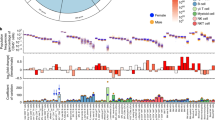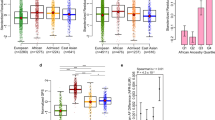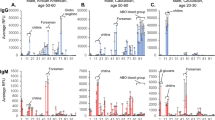Abstract
Immunoglobulin G (IgG) glycosylation is essential for function of the immune system, but the genetic and environmental factors that underlie its inter-individual variability are not well defined. The Collaborative Cross (CC) genetic resource harnesses over 90% of the common genetic variation of the mouse. By analyzing the IgG glycome composition of 95 CC strains, we made several important observations: (i) glycome variation between mouse strains was higher than between individual humans, despite all mice having the same environmental influences; (ii) five genetic loci were found to be associated with murine IgG glycosylation; (iii) variants outside traditional glycosylation site motifs affected glycome variation; (iv) bisecting N-acetylglucosamine (GlcNAc) was produced by several strains although most previous studies have reported the absence of glycans containing the bisecting GlcNAc on murine IgGs; and (v) common laboratory mouse strains are not optimal animal models for studying effects of glycosylation on IgG function.
This is a preview of subscription content, access via your institution
Access options
Access Nature and 54 other Nature Portfolio journals
Get Nature+, our best-value online-access subscription
$29.99 / 30 days
cancel any time
Subscribe to this journal
Receive 12 print issues and online access
$259.00 per year
only $21.58 per issue
Buy this article
- Purchase on Springer Link
- Instant access to full article PDF
Prices may be subject to local taxes which are calculated during checkout





Similar content being viewed by others
References
Schroeder, H. W. J. Jr. & Cavacini, L. Structure and function of immunoglobulins. J. Allergy Clin. Immunol. 125 (Suppl. 2), S41–S52 (2010).
Karsten, C. M. et al. Anti-inflammatory activity of IgG1 mediated by Fc galactosylation and association of FcγRIIB and dectin-1. Nat. Med. 18, 1401–1406 (2012).
Quast, I. et al. Sialylation of IgG Fc domain impairs complement-dependent cytotoxicity. J. Clin. Invest. 125, 4160–4170 (2015).
Kaneko, Y., Nimmerjahn, F. & Ravetch, J. V. Anti-inflammatory activity of immunoglobulin G resulting from Fc sialylation. Science 313, 670–673 (2006).
Masuda, K. et al. Enhanced binding affinity for FcγRIIIa of fucose-negative antibody is sufficient to induce maximal antibody-dependent cellular cytotoxicity. Mol. Immunol. 44, 3122–3131 (2007).
Ruhaak, L. R. et al. The serum immunoglobulin G glycosylation signature of gastric cancer. EuPA Open Proteom. 6, 1–9 (2015).
Saldova, R. et al. Ovarian cancer is associated with changes in glycosylation in both acute-phase proteins and IgG. Glycobiology 17, 1344–1356 (2007).
Vučković, F. et al. IgG glycome in colorectal cancer. Clin. Cancer Res. 22, 3078–3086 (2016).
Parekh, R. B. et al. Association of rheumatoid arthritis and primary osteoarthritis with changes in the glycosylation pattern of total serum IgG. Nature 316, 452–457 (1985).
Trbojević Akmačić, I. et al. Inflammatory bowel disease associates with proinflammatory potential of the immunoglobulin G glycome. Inflamm. Bowel Dis. 21, 1237–1247 (2015).
Vučković, F. et al. Association of systemic lupus erythematosus with decreased immunosuppressive potential of the IgG glycome. Arthritis Rheumatol. 67, 2978–2989 (2015).
Bondt, A. et al. Immunoglobulin G (IgG) Fab glycosylation analysis using a new mass spectrometric high-throughput profiling method reveals pregnancy-associated changes. Mol. Cell. Proteomics 13, 3029–3039 (2014).
Krištić, J. et al. Glycans are a novel biomarker of chronological and biological ages. J. Gerontol. A Biol. Sci. Med. Sci. 69, 779–789 (2014).
Krištić, J., Zoldoš, V. & Lauc, G. in Glycoscience: Biology and Medicine (ed. Endo, T. et al.) 1–7 (Springer Japan, Tokyo, 2014).
Lauc, G. et al. Loci associated with N-glycosylation of human immunoglobulin G show pleiotropy with autoimmune diseases and haematological cancers. PLoS Genet. 9, e1003225 (2013).
Menni, C. et al. Glycosylation of immunoglobulin G: role of genetic and epigenetic influences. PLoS One 8, e82558 (2013).
Pucic, M. et al. High throughput isolation and glycosylation analysis of IgG-variability and heritability of the IgG glycome in three isolated human populations. Mol. Cell. Proteomics 10, M111.010090 (2011).
Blomme, B. et al. Alterations of serum protein N-glycosylation in two mouse models of chronic liver disease are hepatocyte and not B cell driven. Am. J. Physiol. Gastrointest. Liver Physiol. 300, G833–G842 (2011).
Maresch, D. & Altmann, F. Isotype-specific glycosylation analysis of mouse IgG by LC-MS. Proteomics 16, 1321–1330 (2016).
Raju, T. S., Briggs, J. B., Borge, S. M. & Jones, A. J. S. Species-specific variation in glycosylation of IgG: evidence for the species-specific sialylation and branch-specific galactosylation and importance for engineering recombinant glycoprotein therapeutics. Glycobiology 10, 477–486 (2000).
Mizuochi, T., Hamako, J. & Titani, K. Structures of the sugar chains of mouse immunoglobulin G. Arch. Biochem. Biophys. 257, 387–394 (1987).
Mahan, A. E. et al. A method for high-throughput, sensitive analysis of IgG Fc and Fab glycosylation by capillary electrophoresis. J. Immunol. Methods 417, 34–44 (2015).
Morahan, G., Balmer, L. & Monley, D. Establishment of “The Gene Mine”: a resource for rapid identification of complex trait genes. Mamm. Genome 19, 390–393 (2008).
Churchill, G. A. et al. The Collaborative Cross, a community resource for the genetic analysis of complex traits. Nat. Genet. 36, 1133–1137 (2004).
Ferguson, B. et al. Melanoma susceptibility as a complex trait: genetic variation controls all stages of tumor progression. Oncogene 34, 2879–2886 (2015).
Everest-Dass, A. V., Abrahams, J. L., Kolarich, D., Packer, N. H. & Campbell, M. P. Structural feature ions for distinguishing N- and O-linked glycan isomers by LC-ESI-IT MS/MS. J. Am. Soc. Mass Spectrom. 24, 895–906 (2013).
Baković, M. P. et al. High-throughput IgG Fc N-glycosylation profiling by mass spectrometry of glycopeptides. J. Proteome Res. 12, 821–831 (2013).
de Haan, N. et al. The N-glycosylation of mouse immunoglobulin G (IgG)-fragment crystallizable differs between IgG subclasses and strains. Front. Immunol. 8, 608 (2017).
Knežević, A. et al. Effects of aging, body mass index, plasma lipid profiles, and smoking on human plasma N-glycans. Glycobiology 20, 959–969 (2010).
Luan, J. J. et al. Defective Fc gamma RII gene expression in macrophages of NOD mice: genetic linkage with up-regulation of IgG1 and IgG2b in serum. J. Immunol. 157, 4707–4716 (1996).
Natsuume-Sakai, S., Motonishi, K. & Migita, S. Quantitative estimations of five classes of immunoglobulin in inbred mouse strains. Immunology 32, 861–866 (1977).
Nairn, A. V. et al. Regulation of glycan structures in animal tissues: transcript profiling of glycan-related genes. J. Biol. Chem. 283, 17298–17313 (2008).
Yamamoto-Hino, M. et al. Identification of genes required for neural-specific glycosylation using functional genomics. PLoS Genet. 6, e1001254 (2010).
Huffman, J. E. et al. Polymorphisms in B3GAT1, SLC9A9 and MGAT5 are associated with variation within the human plasma N-glycome of 3533 European adults. Hum. Mol. Genet. 20, 5000–5011 (2011).
Lauc, G. et al. Genomics meets glycomics—the first GWAS study of human N-glycome identifies HNF1α as a master regulator of plasma protein fucosylation. PLoS Genet. 6, e1001256 (2010).
Takahashi, M., Kuroki, Y., Ohtsubo, K. & Taniguchi, N. Core fucose and bisecting GlcNAc, the direct modifiers of the N-glycan core: their functions and target proteins. Carbohydr. Res. 344, 1387–1390 (2009).
Davies, J. et al. Expression of GnTIII in a recombinant anti-CD20 CHO production cell line: Expression of antibodies with altered glycoforms leads to an increase in ADCC through higher affinity for FC gamma RIII. Biotechnol. Bioeng. 74, 288–294 (2001).
Longmore, G. D. & Schachter, H. Product-identification and substrate-specificity studies of the GDP-l-fucose:2-acetamido-2-deoxy-β-d-glucoside (FUC→Asn-linked GlcNAc) 6-α-l-fucosyltransferase in a Golgi-rich fraction from porcine liver. Carbohydr. Res. 100, 365–392 (1982).
Bodman, K. B. et al. IgG glycosylation in autoimmune-prone strains of mice. Clin. Exp. Immunol. 95, 103–107 (1994).
Franceschi, C. et al. Inflamm-aging. An evolutionary perspective on immunosenescence. Ann. NY Acad. Sci. 908, 244–254 (2000).
De Martinis, M., Franceschi, C., Monti, D. & Ginaldi, L. Inflamm-ageing and lifelong antigenic load as major determinants of ageing rate and longevity. FEBS Lett. 579, 2035–2039 (2005).
Bennett, B. J. et al. A high-resolution association mapping panel for the dissection of complex traits in mice. Genome Res. 20, 281–290 (2010).
Ugrina, I., Campbell, H. & Vučković, F. Laboratory experimental design for a glycomic study. Methods Mol. Biol. 1503, 13–19 (2017).
Cooper, C. A., Gasteiger, E. & Packer, N. H. GlycoMod–a software tool for determining glycosylation compositions from mass spectrometric data. Proteomics 1, 340–349 (2001).
Ceroni, A. et al. GlycoWorkbench: a tool for the computer-assisted annotation of mass spectra of glycans. J. Proteome Res. 7, 1650–1659 (2008).
Pezer, M. et al. Effects of allergic diseases and age on the composition of serum IgG glycome in children. Sci. Rep. 6, 33198 (2016).
Selman, M. H. J. et al. Fc specific IgG glycosylation profiling by robust nano-reverse phase HPLC-MS using a sheath-flow ESI sprayer interface. J. Proteomics 75, 1318–1329 (2012).
Jansen, B. C. et al. LaCyTools: a targeted liquid chromatography-mass spectrometry data processing package for relative quantitation of glycopeptides. J. Proteome Res. 15, 2198–2210 (2016).
Ram, R., Mehta, M., Balmer, L., Gatti, D. M. & Morahan, G. Rapid identification of major-effect genes using the collaborative cross. Genetics 198, 75–86 (2014).
Cheng, R., Abney, M., Palmer, A. A. & Skol, A. D. QTLRel: an R package for genome-wide association studies in which relatedness is a concern. BMC Genet. 12, 66 (2011).
Acknowledgements
We thank Geniad Pty Ltd for generously providing CC mice and genotypes. This project was supported in part by the WA Diabetes Research Foundation (to G.M.), Program 1037321 (to G.M.) and Project 1069173 (to G.M.) from the National Health and Medical Research Council of Australia and by European Commission FP7 grants MIMOmics (contract 305280 to G.L.) and H2020 projects GlySign (contract 722095 to G.L.), SYSCID (contract #733100 to G.L.) and IMforFuture (contract 721815 to G.L.), as well as by the European Structural and Investment Funds IRI (grant KK.01.2.1.01.0003 to G.L.) and Croatian National Centre of Research Excellence in Personalized Healthcare (grant KK.01.1.1.01.0010 to G.L.).
Author information
Authors and Affiliations
Contributions
Q.N., K.M.D. and G.M. provided samples; J.K., O.O.Z., I.T.-A., M.N., M.P., G.M. and G.L. planned experiments; J.K., M.N., M.V. and O.O.Z. performed experiments; R.R., O.O.Z. and F.V. analyzed data; J.K., G.M. and G.L. wrote the manuscript.
Corresponding author
Ethics declarations
Competing interests
G.L. is founder and owner of Genos Ltd, which specializes in high-throughput glycomics analysis and has several patents in the field. G.M. holds stock in Geniad Pty Ltd.
Additional information
Publisher’s note: Springer Nature remains neutral with regard to jurisdictional claims in published maps and institutional affiliations.
Supplementary information
Supplementary Text and Figures
Supplementary Figures 1–9 and Supplementary Tables 1–8
Supplementary Dataset 1
List of candidate genes involved in the regulation of mouse IgG glycosylation identified from the QTL analysis.
Supplementary Dataset 2
Strain, sex and age of mice.
Rights and permissions
About this article
Cite this article
Krištić, J., Zaytseva, O.O., Ram, R. et al. Profiling and genetic control of the murine immunoglobulin G glycome. Nat Chem Biol 14, 516–524 (2018). https://doi.org/10.1038/s41589-018-0034-3
Received:
Accepted:
Published:
Issue Date:
DOI: https://doi.org/10.1038/s41589-018-0034-3
This article is cited by
-
Age-dependent genetic regulation of osteoarthritis: independent effects of immune system genes
Arthritis Research & Therapy (2023)
-
Unravelling the genetic causality of immunoglobulin G N-glycans in ischemic stroke
Glycoconjugate Journal (2023)
-
Integrated glycomics and genetics analyses reveal a potential role for N-glycosylation of plasma proteins and IgGs, as well as the complement system, in the development of type 1 diabetes
Diabetologia (2023)
-
Comparative analysis of transferrin and IgG N-glycosylation in two human populations
Communications Biology (2023)
-
Pregnancy enables antibody protection against intracellular infection
Nature (2022)



